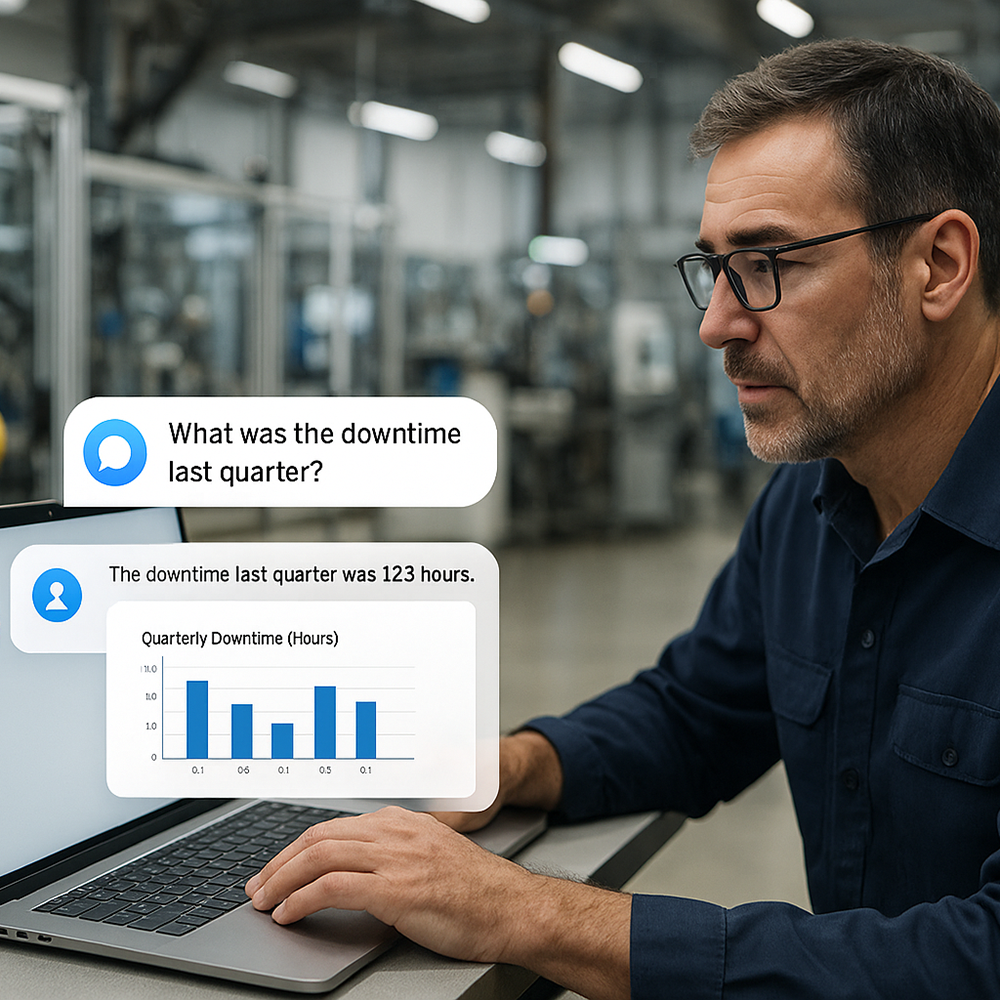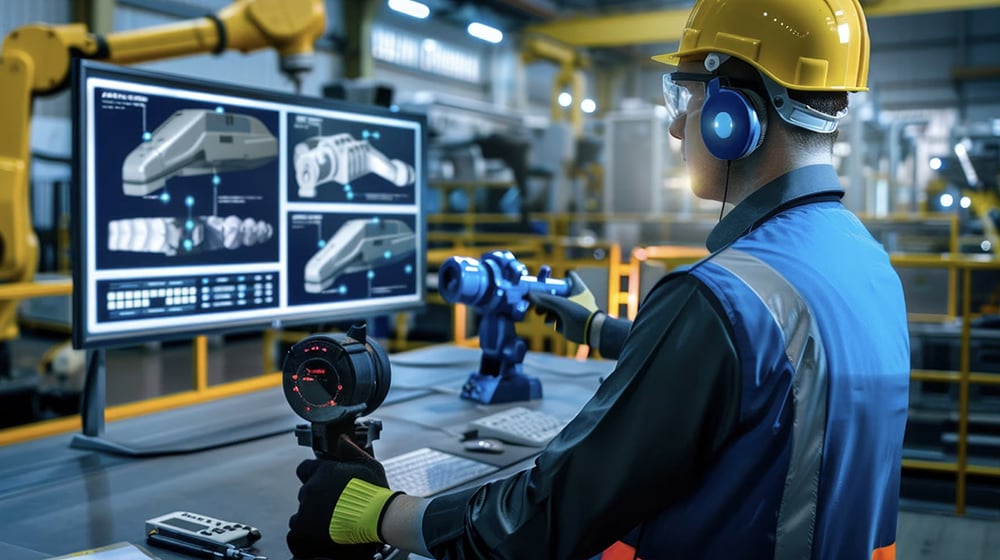Measure
Conversational AI Manufacturing
Data Intelligence™
Real-Time Answers for Modern Factories and Plants
Conversational AI
Turning Factory Questions into Real-Time, Revenue-Boosting Insights
Unplanned downtime already costs the world’s 500 largest manufacturers US $1.4 trillion a year—11 % of total revenue (Siemens, 2024). Yet only 29 % of factories use AI for real‑time decisions and just 24 % have piloted generative AI (Deloitte, 2025). Conversational AI Manufacturing Data Intelligence™ fixes both gaps. Chat with your MES, ERP, SCADA, PLM, or QMS in plain English; On‑the‑Fly BI™ converts the question into just‑in‑time analytics and replies in seconds. Early pilots show ↗ 13 % yield gains and ↘ 204 % audit‑prep time while slashing report backlogs. Think of it as ChatGPT for your factory—but with ISO 27001 security and zero dashboards.


Double Click
How Conversational AI Works
Conversational AI lets people interact with software by typing or speaking naturally. A large‑language model (LLM) interprets intent, fetches data, and returns the answer in prose, tables, or charts.
Why Factories Need it
Everyday Headache
❌ Reporting Delays
Operators wait hours for analysts to build a report.
❌ Onboarding Drag
New hires spend weeks learning MES screens.
❌ Outdated Insights
Executives review stale KPIs in Monday meetings.
❌ System Overload
Engineers juggle MES, SCADA, QMS, ERP tabs.
Conversational AI Fix
Instant Diagnosis
Operator types “Why is Line 4 slow?”—gets root‑cause chart instantly.
Effortless Metrics
They ask “Show today’s OEE” and skip the tool maze.
Live Reporting
They ask “Last‑hour throughput by plant” mid‑meeting.
Unified Access
One chat window spans every system.
Insights From Your Data, On-Demand
What Is On‑the‑Fly BI™?
On‑the‑Fly BI™ is the real‑time analytics engine behind Conversational AI Manufacturing Data Intelligence™. Imagine the SQL queries, pivot tables, and dashboards your analysts build—but executed only when you ask, against fresh data, and discarded afterward. No cubes, no nightly ETL.

How It Connects to Conversational AI
1. You Ask
"Why did Line 3 scrap spike yesterday?” (Conversational AI parses intent)
2. Translate
Intent becomes a secure, structured query.
3. Analyze
4. Answer
Conversational AI formats the insight and next‑step recommendation.
5. Automate
With one click you can save any answer as a report recipe: set cadence (hourly, daily, weekly) and choose a delivery channel—email, Slack, Google Chat, or Microsoft Teams. On‑the‑Fly BI™ re‑runs the live query at send‑time, guaranteeing fresh numbers every cycle.
Industry Landscape & Stats

Downtime Impact
Automotive plants lose US $2.3 million per hour of unplanned downtime (Siemens, 2024).

Adoption Gap
Only 24 % of manufacturers have deployed generative AI at the facility or network level (Deloitte, 2025).

Market Growth
Gartner expects the conversational AI platform market to reach US $18.4 billion by 2026, a 21.9 % CAGR (Gartner, 2024).

Real world Momentum
Microsoft’s Factory Operations Agent helped Schaeffler diagnose defects across global plants in minutes (Brandom, 2025).
From Theory to Practice
Measure Knowledge Topics
Explore a curated library of essential manufacturing topics. Each entry includes a concise 200-word overview for quick learning and an in-depth 800-word article for deeper insights into standards, systems, and best practices.
Siemens Opcenter MES + Conversational AI: Instant Answers from SFCs, NCs & Traceability
Use natural‑language queries to pull SFC histories, NCs, routings, and full genealogy in seconds—no custom reports; includes example prompts and sub‑hour/source onboarding.
Multi-CAD in Teamcenter: how JT makes reviews universal
Use natural‑language queries to pull SFC histories, NCs, routings, and full genealogy in seconds—no custom reports; includes example prompts and sub‑hour/source onboarding.
Yield & Scrap – Ask-and-Act Troubleshooting for Faster Quality Wins
Expose recurring waste and micro stops fast; “Ask this → Get that” prompts for fabs and discrete manufacturing.
Changeovers & Cycle Time – Find the Hidden Minutes with Chat-Driven Queries
Compare identical assets/lines across plants; capture and propagate winning SOPs with measurable deltas.
Audit Readiness & Digital Traceability – Compliance in Seconds, Not Weeks
Assemble ISO 13485/FDA device‑history packets on demand with approvals, e‑signatures, and immutable logs.
Cross-Site Benchmarking & SOP Harvesting – Scaling Excellence Across the Enterprise
Compare identical assets/lines across plants; capture and propagate winning SOPs with measurable deltas.
Closed Loop Manufacturing – Continuous Improvement at Scale
Seven practical steps connecting PLM ↔ MES ↔ APS ↔ IIoT; where conversational intelligence shortens detect, decide, act.
What Conversational AI Can and Cannot Do in Manufacturing (and When to Add Predictive, IIoT, and Computer Vision)
Seven practical steps connecting PLM ↔ MES ↔ APS ↔ IIoT; where conversational intelligence shortens detect, decide, act.
From Theory to Practice
Measure Knowledge Topic
Explore a curated library of essential manufacturing topics. Each entry includes a concise 200-word overview for quick learning and an in-depth 800-word article for deeper insights into standards, systems, and best practices.
Siemens Opcenter + Conversational AI
Use natural-language queries to pull SFC histories, NCs, routings, and full genealogy in seconds—no custom reports; includes example prompts and sub-hour/source on-boarding.
Read More
On-the-Fly BI™ Explained
Walk the intent → secure query → live crunch → chart loop and show how any answer becomes a scheduled report via email, Slack, Google Chat, or Microsoft Teams.
Read More
Yield & Scrap
Expose recurring waste and micro stops fast; “Ask this → Get that” prompts for fabs and discrete manufacturing.
Read More
Changeovers & Cycle Time
Spot bottlenecks and over cycle stations; quantify impact of recipe/tooling tweaks across shifts.
Read More
Audit Readiness & Digital Traceability
Assemble ISO 13485/FDA device history packets on demand with approvals, e-signatures, and immutable logs.
Read More
Cross Site Benchmarking & SOP Harvesting
Compare identical assets/lines across plants; capture and propagate winning SOPs with measurable deltas.
Read More
Closed Loop Manufacturing
Seven practical steps connecting PLM ↔ MES ↔ APS ↔ IIoT; where conversational intelligence shortens detect, decide, act.
Read More
What Conversational AI Can—and Cannot—Do in Manufacturing
Set expectations; great at cross system retrieval and guidance, pairs with predictive maintenance, anomaly detection, and computer vision for forecasting and control.
Read More
How‑To / Best Practices
1. Connect securely
Use pre‑built connectors for Siemens Opcenter™, SAP S/4HANA™, Ignition™, and Teamcenter™.
2. Define entities
3. Start with questions, not dashboards
4. Pilot one line first
5. Validate answers
Compare Conversational AI Manufacturing Data Intelligence™ output to existing reports for two weeks; tune synonyms and thresholds.
6. Roll out across shifts
7. Measure success

Case Studies & Examples

Semiconductor Fab – Yield Boost
Problem – Trace defects exceeded 5 ppm; root‑cause digging took 3 days.
Approach – Connected Siemens Opcenter™ and SCADA tags to Conversational AI Manufacturing Data Intelligence™; operators asked “What shifted before defect spike?”
Result – Identified coolant‑flow anomaly in < 90 s; ↗ 13 % yield in two weeks.

Medical Device Plant – Audit Prep
Problem – FDA traceability packet generation consumed 120 person‑hours per audit.
Approach – Used Conversational AI Manufacturing Data Intelligence™ to generate device‑history records on demand.
Result – ↘ 204 % audit‑prep effort; auditors accepted digital packet on first submission.

Food & Bev – Predictive Maintenance
Problem – Filler micro‑stops caused 2 h/week downtime.
Approach – Integrated vibration sensors; maintenance techs asked via chat which
bearings would fail next week.
Result – ↘ 9 % unplanned downtime, saving US $1.1 M/year.
Product Comparison
| Feature | Conversational Ai Manufacturing Data Intelligence | Traditional BI Dashboards | Generic Chatbot |
| Set-up Time | <1 Day per data source |
4-6 weeks cube build |
2 weeks intent training |
| SQL Skills Needed | NO |
YES |
No |
| Real-time Data | Yes (On-the-Fly) |
Hourly / Overnight |
Limited |
| Multi-system Coverage | MES, ERP, SCADA, PLM, QMS |
Usually one |
Usually one |
| Security | ISO 27001, SSO |
Varies |
Varies |
| Natural Language Insight | Charts + Actions |
Static Tables |
Short text |
Frequently Asked Questions
- What data sources can Conversational AI Manufacturing Data Intelligence™ connect to?
Any SQL‑based or REST‑accessible MES, ERP, SCADA, PLM, or QMS. Pre‑built connectors ship for Siemens Opcenter™, SAP S/4HANA™, Ignition™, and Teamcenter™—custom sources plug in via our SDK. - Can a one‑off answer become a recurring report?
Yes—click Save as Report, choose a cadence (hourly, daily, weekly) and a delivery channel (email, Slack, Google Chat, or Microsoft Teams). On‑the‑Fly BI™ reruns the live query at send‑time, so numbers are always current. - How long does initial deployment take?
Most plants start asking live questions in under one business day per connected data source thanks to schema autodetect and no‑code connectors. - Does this replace my existing BI dashboards?
Think of it as a conversational overlay. Dashboards stay for monitoring; Conversational AI Manufacturing Data Intelligence™ answers the ad‑hoc “why” and “what if” questions dashboards can’t anticipate. - How is my data secured?
We operate in ISO 27001‑certified data centers, enforce single‑tenant storage, and support SSO with role‑based access controls. No data is used for model training.
References
Abdelaal, M. (2024). AI in Manufacturing: Market Analysis & Opportunities (arXiv:2407.05426). https://arxiv.org/abs/2407.05426
This source is relevant if you want a concise synthesis of where AI is actually being applied in factories and what’s blocking wider usage. You’ll find a literature review with market sizing, adoption patterns, and practical considerations across discrete and process industries. Two takeaways we used: adoption is uneven and concentrated in a few high‑value use cases; success hinges on unifying siloed data rather than model choice alone.
Brandom, R. (2025, February 24). AI Assistants Join the Factory Floor. WIRED. https://www.wired.com/story/ai-swaps-desk-work-for-the-factory-floor
This article is useful for seeing real plants put conversational agents to work, not just lab demos. You’ll find reporting on Schaeffler and others using assistants to surface live manufacturing data and speed diagnoses. Two takeaways we used: shop‑floor acceptance rises when answers are grounded in live systems; conversational interfaces shorten the time from question to corrective action.
Deloitte. (2025, May 1). 2025 Smart Manufacturing and Operations Survey. https://www.deloitte.com/us/en/insights/industry/manufacturing-industrial-products/2025-smart-manufacturing-survey.html
This is the benchmarking study to read if you want hard numbers on adoption and talent gaps. You’ll find executive‑level stats on gen‑AI pilots, scaling barriers, and expected ROI horizons. Two takeaways we used: only about a quarter of manufacturers have deployed gen‑AI at scale; skill shortages remain a top obstacle to realizing value.
Gartner. (2024, April 3). Market Guide for Conversational AI Solutions. https://www.genesys.com/resources/market-guide-for-conversational-ai-solutions
This guide is relevant for understanding how analysts define the conversational‑AI solution landscape and what capabilities enterprises should require. You’ll find a framework that covers NLU, orchestration, connectors, guardrails, and buying considerations for enterprise deployments (registration required via an authorized distributor). Two takeaways we used: platforms must orchestrate queries across multiple systems; governance and security controls are first‑class requirements in industrial settings.
McKinsey. (2025). AI in the Workplace: 2025 Report.
https://www.mckinsey.com/capabilities/mckinsey-digital/our-insights/superagency-in-the-workplace-empowering-people-to-unlock-ais-full-potential-at-work
This report is relevant if you want to understand how AI assistants change day‑to‑day work and where productivity actually shows up. You’ll find a large‑scale survey and case analyses covering task patterns, adoption hurdles, and the “superagency” model for empowering employees. Two takeaways we used: time‑to‑insight drives most of the measurable gains; assistants deliver outsized value when integrated with core enterprise systems rather than used in isolation.
Mok, A. (2025, May 13). How AI and Robotics Prevent Breakdowns in Factories. Business Insider. https://www.businessinsider.com/artificial-intelligence-robotics-predictive-maintenance-manufacturing-factory-solutions-2025-5
This piece is helpful if you want an accessible primer on predictive maintenance and downtime prevention with AI. You’ll find case vignettes that connect sensor data, anomaly detection, and decision workflows to concrete savings. Two takeaways we used: predictive maintenance delivers quick wins when paired with operator workflows; even modest downtime reductions compound into seven‑figure savings annually.
Siemens AG. (2024). The True Cost of Downtime (White paper). https://assets.new.siemens.com/siemens/assets/api/uuid:1b43afb5-2d07-47f7-9eb7-893fe7d0bc59/TCOD-2024_original.pdf
Read this to quantify why speed to insight matters in manufacturing. You’ll find per‑hour loss figures by sector and a global estimate of annual downtime costs with methodology notes. Two takeaways we used: unplanned downtime can exceed US$2M per hour in some verticals; total annual impact exceeds a trillion dollars—justifying real‑time, question‑driven analytics.
